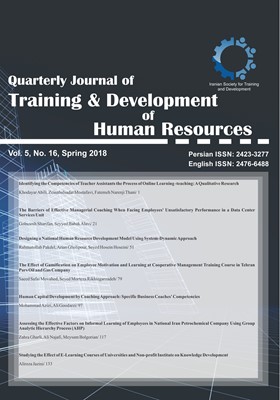Identifying and Explaining the Dimensions, Components and Indicators of the Electronic Learning Management System at the Maskan Bank
Subject Areas :
ali reza nasirinia
1
,
Amir hossein Mahmoodi
2
,
yalda delgoshaei
3
,
ali reza badeleh
4
![]()
1 -
2 -
3 -
4 - Faculty member of Farhangiyan University
Keywords: E-learning, Assessment, Electronic learning management system.,
Abstract :
The purpose of this study was to identify and explain the dimensions, components and indicators of the electronic learning management system in the Maskan Bank. The research method is applied in terms of purpose, and in terms of how information is collected, it is qualitative. In this research, after the purposeful sampling, the process of interviewing with key and informed experts until the identification and full description of the dimensions, components and indicators, and the achievement of theoretical saturation persisted. To determine the logical framework of the total collected data, the steps were taken to identify, note and classify the concepts. For this purpose, the collected data were aggregated and the texts were re-examined and categorized as major categories. Finally, the categories were reviewed, repetitive deletions, similar and smaller mergers, and the dimensions of the specified topic were ranked within the framework of the components and indicators. Based on the results, the extracted model has 4 dimensions, 5 components and 30 indicators for assessing the electronic learning management system. After finalizing the data analysis and extracting the conceptual model, in order to measure the validity of the model with 10 experts and experts of the bank in the form of a focal group about the dimensions, components and indicators of the model of consensus and agreement.
1. Aldridge S, Rowley J. Measuring customer satisfaction in higher education. Quality Assurance in Education, 2014; 6(4), 197‐204.
2. Anari-Nejad A, Safavi A-A, Mohammadi M. Evaluating E-learning with Optimization Approach Case Study of Higher Education in Iran. Journal of Information and Communication,1393; 4 (11), 19-25.
3. Arkorful V, Abaidoo N. The role of e‐learning, advantages and disadvantages of its adoption in higher education. Instructional Technology, 2015; 12(1), 29‐77.
4. Ibrahim O. Suggested Model for E‐learning Quality service. Journal Of Business Management & Social Sciences Research, 2015; 4(1), 54‐58
5. Akbari bourang M, Jafari sani H, Ahanchian M, Karashki H. Evaluating the quality of Iranian university electronic learning. Quarterly Journal of Research and Planning in Higher Education, 1391; 8 (66), 75-97.
6. Anderson T. “Is e-Learning Right for Your Organization?” http://www.learningcircuits.org/2002/jan2002/anderson.htm.2012.
7. Utarkhani A, Delavari V (1391). Evaluating student satisfaction with e-learning systems. Prospect of Commercial Management, 15 (10), 113-132.
8. Shaik N. Lowe S. Pinegar K. A multiple‐item scale for measuring service quality of online distance learning programs, Online Journal of Distance Learning Administration, IX(II). 2016.
9. Marshall S, Mitchell G. E‐Learning Process Maturity in the New Zealand Tertiary Sector. Paper presented at the EDUCAUSE in Australasia 2005 Conference:Auckland, April 5‐ 8. 2015.
10. Kelly T, Bauer D. Managing Intellectual capital via e‐learning at Cisco, C. Holsapple (Ed.). Handbook on knowledge management, 2014; 511–532.
11. Wu H, Lin H. A hybrid approach to develop an analytical model for enhancing the service quality of e‐learning, Computers & Education, 2012; 58(4), 1318‐1338.
12. Clawson L. Dose quality matter? Measuring whether online course quality standards are predictive of student satisfaction in higher education. A Dissertation philosophy, capella university.2007.
13. Pomales-Garcia C, Liu Y. Web-based distance learning technology: The impacts of web module length and format. The American journal of distance education,2006; 20(3), 163-179.
14. Feizi K, Behzadi A. A model for assessing the readiness of deploying e-learning systems in organizations and financial institutions. Journal of Educational Technology,1393; 8 (3).
15. Ghorbanzadeh v, Hasan nangir Seyed T, Roodsaz H. Meta-analysis of factors affecting the adoption of information technology in Iran. Management Studies in Iran. 1391; 17 (2), 177-196.
16. Kheirandish M, Salehi Sedghiani J. Model for assessing the readiness of virtual education (Case study: Headquarters of the National Iranian Oil Products Distribution Company). Quarterly Journal of Human Resource Management in Oil Industry, 1390; 10 (17), 83-104.
17. Sugant R A Framework for Measuring Service Quality of E‐Learning Services. Proceedings of the Third International Conference on Global Business, Economics, Finance and Social Sciences ,(GB14Mumbai Conference) Mumbai, India. 19‐21 December 2014.
18. Hassanzadeh A, Kanaani F, Elahi S. A model for measuring e‐learning systems success in universities. Expert Systems with Applications,2012; 39(12), 10959‐ 10966.
19. Masoumi D. Quality in E‐learning in a Cultural Context, The case of Iran. Doctoral Theses from University of Gothenburg, Gothenburg Studies in Educational Sciences.2010
20. Mirghfouri S, SayyadiToranloo H, Kariminia M. Ranking Factors Affecting Innovation Promotion in Growth Centers Affiliated Companies Using Fuzzy Topsis Technique.2013
21. Zeithaml V. A, Parasuraman A, Malhotra A. Service Quality Delivery Through Web Sites, A Critical Review of Extant Knowledge, Journalof he Academy of Marketing Science,2012; 30(4), 362‐375.
22. Subrahmanyam A, Raja Shekhar B. HiEduQual: An Instrument for Measuring the Critical Factors of Students’ Perceived Service Quality, Management Science and Engineering ,2014; 8(2), 102‐108.


